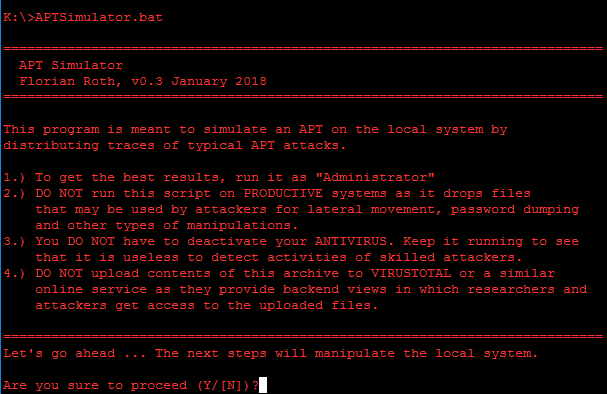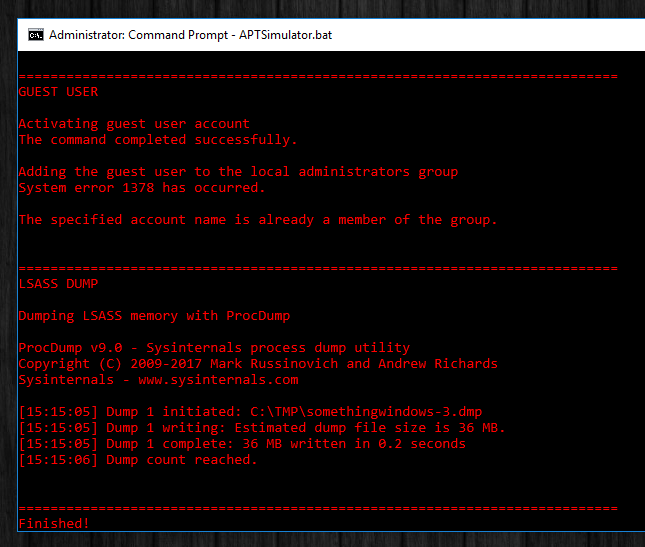APT Simulator is a Windows Batch script that uses a set of tools and output files to make a system look as if it was compromised.
Use Cases
- POCs: Endpoint detection agents / compromise assessment tools
- Test your security monitoring's detection capabilities
- Test your SOCs response on a threat that isn't EICAR or a port scan
- Prepare an environment for digital forensics classes
Motives
Customers tested our scanners in a POC and sent us a complaint that our scanners didn't report on programs that they had installed on their test systems. They had installed an Nmap, dropped a PsExec.exe in the Downloads folder and placed on EICAR test virus on the user's Desktop. That was the moment when I decided to build a tool that simulates a real threat in a more appropriate way.
Why Batch?
- Because it's simple: Everyone can read, modify or extend it
- It runs on every Windows system without any prerequisites
- It is closest to a real attacker working on the command line
Focus
The focus of this tool is to simulate adversary activity, not malware.
Getting Started
- Download the latest release from the "release" section
- Extract the package on a demo system (Password: apt)
- Start a cmd.exe as Administrator
- Navigate to the extracted program folder and run APTSimulator.bat
Avoiding Early Detection
The batch script extracts the tools and shells from an encrypted 7z archive at runtime. Do not download the master repo using the "download as ZIP" button. Instead use the official release from the release section.
Extending the Test Set
Since version 0.4 it is pretty easy to extend the test sets by adding a single .bat file to one of the test-set category folders.
E.g. If you want to write a simple use case for "privilege escalation", that uses a tool named "privesc.exe", clone the repo and do the following:
- Add you tool to the
toolsetfolder - Write a new batch script
privesc-1.batand add it to the./test-sets/privilege-escalationfolder - Run
build_pack.bat - Add your test to the table and action list in the README.md
- Create a pull request
Tool and File Extraction
If you script includes a tool, web shell, auxiliary or output file, place them in the folders ./toolset or ./workfiles. Running the build script build_pack.bat will include them in the encrypted archives enc-toolset.7z and enc-files.7z.
Extract a Tool
%ZIP% e -p%PASS% %TOOLARCH% -aoa -o%APTDIR% toolset\tool.exe > NULExtract a File
%ZIP% e -p%PASS% %FILEARCH% -aoa -o%APTDIR% workfile\tool-output.txt > NULDetection
The following table shows the different test cases and the expected detection results.
- AV = Antivirus
- NIDS = Network Intrusion Detection System
- EDR = Endpoint Detection and Response
- SM = Security Monitoring
- CA = Compromise Assessment
| Test Case | AV | NIDS | EDR | SM | CA |
|---|---|---|---|---|---|
| Dumps (Pwdump, Dir Listing) | X | ||||
| Recon Activity (Typical Commands) | X | X | X | ||
| DNS (Cache Injection) | (X) | X | X | X | |
| Eventlog (WCE entries) | X | X | X | ||
| Hosts File (AV/Win Update blocks) | (X) | X | X | ||
| Backdoor (StickyKey file/debugger) | X | X | |||
| Obfuscation (RAR with JPG ext) | (X) | ||||
| Web Shells (a good selection) | X | (X) | X | ||
| Ncat Alternative (Drop & Exec) | X | X | X | X | |
| Remote Execution Tool (Drop) | (X) | X | |||
| Mimikatz (Drop & Exec) | X | X | X | X | |
| PsExec (Drop & Exec) | X | X | X | ||
| At Job Creation | X | X | X | ||
| RUN Key Entry Creation | X | X | X | ||
| System File in Susp Loc (Drop & Exec) | X | X | X | ||
| Guest User (Activation & Admin) | X | X | X | ||
| LSASS Dump (with Procdump) | X | X | X | ||
| C2 Requests | (X) | X | X | X | |
| Malicious User Agent (Malware, RATs) | X | X | X | ||
| Scheduled Task Creation | X | X | X | ||
| Nbtscan Discovery (Scan & Output) | X | X | (X) | X |
Test Cases
1. Dumps
- drops pwdump output to the working dir
- drops directory listing to the working dir
2. Recon
- Executes command used by attackers to get information about a target system
3. DNS
- Looks up several well-known C2 addresses to cause DNS requests and get the addresses into the local DNS cache
4. Eventlog
- Creates Windwows Eventlog entries that look as if WCE had been executed
5. Hosts
- Adds entries to the local hosts file (update blocker, entries caused by malware)
6. Sticky Key Backdoor
- Tries to replace sethc.exe with cmd.exe (a backup file is created)
- Tries to register cmd.exe as debugger for sethc.exe
7. Obfuscation
- Drops a cloaked RAR file with JPG extension
8. Web Shells
- Creates a standard web root directory
- Drops standard web shells to that diretory
- Drops GIF obfuscated web shell to that diretory
9. Ncat Alternative
- Drops a PowerShell Ncat alternative to the working directory
10. Remote Execution Tool
- Drops a remote execution tool to the working directory
11. Mimikatz
- Dumps mimikatz output to working directory (fallback if other executions fail)
- Run special version of mimikatz and dump output to working directory
- Run Invoke-Mimikatz in memory (github download, reflection)
12. PsExec
- Dump a renamed version of PsExec to the working directory
- Run PsExec to start a command line in LOCAL_SYSTEM context
13. At Job
- Creates an at job that runs mimikatz and dumps credentials to file
14. RUN Key
- Create a suspicious new RUN key entry that dumps "net user" output to a file
15. System File Suspicious Location
- Drops suspicious executable with system file name (svchost.exe) in %PUBLIC% folder
- Runs that suspicious program in %PUBLIC% folder
16. Guest User
- Activates Guest user
- Adds Guest user to the local administrators
17. LSASS DUMP
- Dumps LSASS process memory to a suspicious folder
18. C2 Requests
- Uses Curl to access well-known C2 servers
19. Malicious User Agents
- Uses malicious user agents to access web sites
20. Scheduled Task Creation
- Creates a scheduled task that runs mimikatz and dumps the output to a file
21. Nbtscan Discovery
- Scanning 3 private IP address class-C subnets and dumping the output to the working directory
Warning
This repo contains tools and executables that can harm your system's integrity and stability. Do only use them on non-productive test or demo systems.
Screenshots
Advanced Solutions
The CALDERA automated adversary emulation system https://github.com/mitre/caldera
Infection Monkey - An automated pentest tool https://github.com/guardicore/monkey
Flightsim - A utility to generate malicious network traffic and evaluate controls https://github.com/alphasoc/flightsim
Integrated Projects / Software







